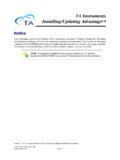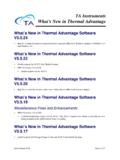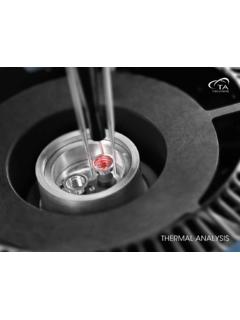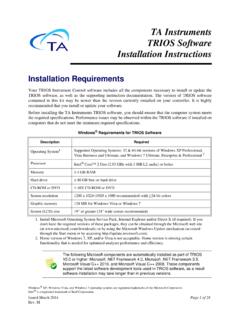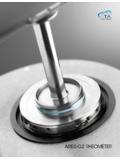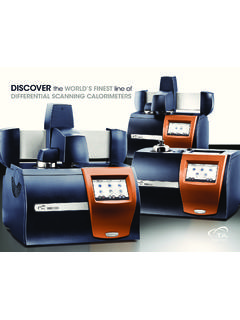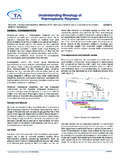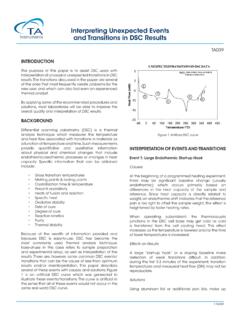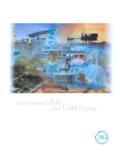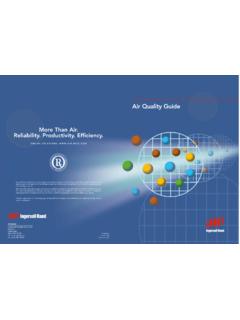Transcription of TA Instruments
1 TA InstrumentsThermal cover:Layout 1 1/18/11 3:56 PM Page 2 DynAMiC MeChAniCAl aNalySiSAccurate, Precise, Versatile DMA Measurements78 DMA Q800 SPeCiFiCatioNS79 Maximum Force 18 NMinimum Force NForce Resolution NStrain Resolution 1 nanometerModulus Range 103 to 3x1012 PaModulus Precision 1%Tan Sensitivity Resolution Range to 200 HzDynamic Sample Deformation Range to 10 000 mTemperature Range -150 to 600 CHeating Rate to 20 C/minCooling Rate to 10 C/minIsothermal Stability CTime/Temperature Superposition YesRH Control Optional Output ValuesStorage Modulus Complex/Dynamic Viscosity TimeLoss Modulus Creep Compliance Stress/StrainStorage/Loss Compliance Relaxation Modulus Frequency Tan Delta ( ) Static/Dynamic Force Sample StiffnessComplex Modulus Temperature DisplacementRelative Humidity (Optional)The Q800 is the world s best-selling DMA, for very good reason. It utilizes state-of-the-art, non-contact, linear drive technology to provide precise control of stress, and air bearings for low friction support.
2 Strain is measured using optical encoder technology that provides unmatched sensitivity and resolution. With its unique design, the Q800 easily outperforms competitive Instruments and is ideal for high-stiffness applications, including composites. 80 DMA deFormatioN modeS & SamPle SizeDual/Single Cantilever 8/4* mm (L), Up to 15 mm (W) and 5 mm (T) 20/10* mm (L), Up to 15 mm (W) and 5 mm (T) 35 * mm (L), Up to 15 mm (W) and 5 mm (T)3-Point Bend 5, 10, or 15 mm (L), Up to 15 mm (W) and 7 mm (T) 20 mm (L), Up to 15 mm (W) and 7 mm (T) 50 mm (L), Up to 15 mm (W) and 7 mm (T)TensionFilm/Fiber 5 to 30 mm (L), Up to 8 mm (W) and 2 mm (T)Fiber 5 to 30 mm (L), 5 denier ( tex) to mm diameterShear 10 mm square, Up to 4 mm (T)Compression 15 and 40 mm diameter, Up to 10 mm (T)Submersion Tension Fixed at 15 mm (L), Up to 8 mm (W) and 2 mm (T)Compression 25 mm diameter, Up to 10 mm (T)3-Point Bend 5, 10, or 15 mm (L), Up to 15 mm (W) and 7 mm (T) *Lengths are for dual/single cantilever81 SubAMbienT oPeratioNGas Cooling AccessoryThe Gas Cooling Accessory (GCA) extends the operating range of the Q800 to -150 C.
3 The GCA uses cold nitrogen gas generated from controlled evaporation of liquid nitrogen. Automated filling of the GCA tank can be programmed to occur after the scan is GCA will provide ballistic or controlled cooling rates over the entire operating range of the Q800 DMA (-150 to 600 C). In general, the maximum cooling rate is a function of the installed clamp and the thermal characteristics of the sample. The figure below shows the typical range* of controlled cooling rates available as a function of C-50 C50 C150 C250 C350 C450 C550 CTe mperature ( C)Cooling Rate ( C/min)0*Actual performance may vary slightly depending on laboratory conditions and the clamping system teChNologyDrive Motor The Q800 uses a non-contact, direct drive motor to provide the oscillatory or static force required. The motor is constructed of high performance composites that ensure low compliance and is thermostated to eliminate heat build-up even when using large oscillation amplitudes and high deformation forces.
4 Sophisticated electronics enable the motor current to be rapidly adjusted in small increments. The motor can deliver reproducible forces over a wide range and the force can be changed rapidly, enabling a broad spectrum of material properties to be Bearings The non-contact drive motor transmits force directly to a rectangular air bearing slide. The slide is guided by eight porous carbon air bearings grouped into two sets of four near the top and bottom of the slide. Pressurized air or nitrogen flows to the bearings forming a frictionless surface that permits the slide to float. The slide, which connects to the drive shaft and sample clamp, can move vertically 25 mm and its rectangular shape eliminates any twisting of the sample. Very weak materials like films and fibers can be characterized with The Q800 features a bifilar wound furnace with automated movement.
5 The furnace design, combined with the Gas Cooling Accessory, provides for efficient and precise temperature control over the entire temperature range, both in heating, cooling, and isothermal operation. The automatic furnace movement simplifies experimental setup. Optical Encoder A high-resolution linear optical encoder is used to measure displacement on the Q800 DMA. Based on diffraction patterns of light through gratings (one moveable and one stationary), optical encoders provide exceptional resolution compared to typical LVDT technology. Due to the excellent 1 nanometer resolution of the optical encoder, very small amplitudes can be measured precisely. This, combined with the non-contact drive motor and air bearing technology, provides excellent modulus precision and high tan sensitivity allowing the Q800 DMA to characterize a broad range of Mass, High Stiffness Sample ClampsThe Q800 features a variety of sample clamps that provide for multiple modes of deformation.
6 The clamps are optimized using finite element analysis to provide high stiffness, with low mass, and attach to the drive shaft with a simple dovetail connection. The clamps are easy to use and adjust, and each is individually calibrated to ensure data accuracy. A broad range of samples can be analyzed. The high stiffness minimizes clamp compliance, and the low mass ensures rapid temperature equilibration. These simple, yet elegant designs reduce the time necessary to change clamps and load samples. Rigid Aluminum Casting The Q800 drive motor, air bearing slide assembly with optical encoder and air bearings are all mounted within a rigid aluminum casting that is temperature controlled. The rigid aluminum housing minimizes system compliance and the temperature-controlled housing ensures precise data. 83 Optical EncoderDrive motorRigid Aluminum CastingLow Mass, High Stiffness Sample ClampsFurnaceAir Bearings84 MoDeS of deFormatioNDual/Single CantileverIn this mode, the sample is clamped at both ends and either flexed in the middle (dual cantilever) or at one end (single cantilever).
7 Cantilever bending is a good general-purpose mode for evaluating thermoplastics and highly damped materials ( , elastomers). Dual cantilever mode is ideal for studying the cure of supported thermosets. A powder clamp is also available for characterizing transitions in powder BendIn this mode, the sample is supported at both ends and force is applied in the middle. 3-point bend is considered a pure mode of deformation since clamping effects are eliminated. The 50 and 20 mm clamps on the Q800 utilize unique low-friction, roller bearing supports that improve SandwichIn this mode, two equal-size pieces of the same material are sheared between a fixed and moveable plate. This mode is ideal for gels, adhesives, high viscosity resins, and other highly damped materials. 85 CompressionIn this mode, the sample is placed on a fixed flat surface and an oscillating plate applies force. Compression is suitable for low to moderate modulus materials ( , foams and elastomers).
8 This mode can also be used to make measurements of expansion or contraction, and tack testing for this mode, the sample is placed in tension between a fixed and moveable clamp. In oscillation experiments, the Instruments use a variety of methods for applying a static load to prevent buckling and unnecessary creep. The clamps are suitable for both films and fibers. Submersible ClampsFilm tension, compression, and 3-point bend clamps are available in submersible configurations for the Q800. These clamps allow samples to be analyzed in a fluid environment up to 80 C. 1001009080706050403020100010203040506070 8090110120 Temperature ( C)Relative Humidity (%)86 DMA aCCeSSorieSDMA-RHThe new DMA-RH Accessory allows mechanical properties of a sample to be analyzed under controlled and/or varying conditions of both relative humidity and temperature. It is designed for use with the Q800 Dynamic Mechanical DMA-RH Accessory is a fully integrated unit and includes the following hardware components:1.
9 The sample chamber mounts to the DMA in place of the standard furnace. Peltier elements in the chamber precisely control the temperature to + C. The sample chamber accommodates standard DMA clamps (tension, cantilever, and 3-point bending). It is quickly removed for conversion back to the standard DMA A heated vapor-transfer line is maintained at a temperature above the dew point temperature of the humidified gas in order to avoid condensation and provide accurate The DMA-RH Accessory contains the humidifier and electronics which continuously monitor and control temperature and humidity of the sample DMA-RH accessory offers the widest range of temperature and relative Range 5 to 120 CTemperature Accuracy CHeating/Cooling Rate Maximum 1 C/minHumidity Range See humidity range Accuracy 5-90% RH: 3% RH >90% RH: 5% RHHumidity Ramp Rate 2% RH/min (fixed)(both increasing and decreasing) 1328788 DMA-rh aPPliCatioNSEffect of Relative Humidity on the Glass Transition of Nylon 6 Nylon 6 is strongly plasticized by water; as such the mechanical properties will be dependent on the surrounding relative humidity.
10 The data in this figure demonstrate the effect of relative humidity on the glass transition of Nylon 6 as measured on the Q800 DMA equipped with the DMA-RH accessory. The sample was analyzed in single cantilever mode at a frequency of 1 Hz at a variety of constant RH conditions. Note how the mechanical properties and glass transition are significantly influenced by the imposed relative of the Coefficient of Hygroscopic Expansion (CHE) Hygroscopy is defined as the ability of a substance to attract water molecules from the surrounding environment through either absorption or adsorption. The effect of moisture sorption on the mechanical characteristics of a material can be quantified by the Coefficient of Hygroscopic Expansion (CHE), the constant which relates the dimensional change of a material to a change in the surrounding relative humidity. The data in this figure show the effect of imposed relative humidity on the Nylon 6 sample as measured by the Q800 DMA with the DMA-RH Accessory.
